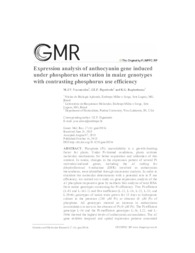Expression analysis of anthocyanin gene induced under phosphorus starvation in maize genotypes with contrasting phosphorus use efficiency.
Expression analysis of anthocyanin gene induced under phosphorus starvation in maize genotypes with contrasting phosphorus use efficiency.
Author(s): VASCONCELOS, M. J. V. de; FIGUEIREDO, J. E. F.; RAGHOTHAMA, K. G.
Summary: Phosphate (Pi) unavailability is a growth-limiting factor for plants. Under Pi-limited conditions, plants activate molecular mechanisms for better acquisition and utilization of this nutrient. In maize, changes in the expression pattern of several Pi starvation-induced genes, including the A1 coding for dihydroflavonol 4-reductase (DFR) involved in anthocyanin biosynthesis, were identified through microarray analysis. In order to elucidate the molecular determinants with a potential role in P use efficiency, we carried out a study on gene expression analysis of the A1 phosphate responsive gene by northern blot analysis of total RNA from maize genotypes contrasting for Pi efficiency. Two Pi-efficient (L-03 and L-161-1) and five inefficient (L-11, L-16, L-22, L-53, and L-5046) genotypes of maize were grown for 15 days in hydroponic culture in the presence (250 ,uM Pi) or absence (0 ,uM Pi) of phosphate. All genotypes showed an increase in anthocyanin accumulation in roots in the absence of Pi (0 ,uM Pi). The Pi-efficient genotype L-36 and the Pi-inefficient genotypes L-16, L22, and L-5046 showed the highest levels of anthocyanin accumulation. The A1 gene exhibits temporal and spatial expression patterns associated with Pi deficiency. Although there were differences in the expression profile of Pi starvation induced genes, no consistent expression patterns could be associated with either Pi-efficient or Pi-inefficient genotypes. It appears that Pi efficiency in tropical maize is a complex trait mediated by a coordinated action of genes that are either induced or suppressed in response to Pi-deficiency.
Publication year: 2018
Types of publication: Journal article
Unit: Embrapa Maize & Sorghum
Keywords: Antocianina, Estresse abióco, Expressão genética, Solo Ácido
Observation
Some of Embrapa's publications are published as ePub files. To read them, use or download one of the following free software options to your computer or mobile device. Android: Google Play Books; IOS: iBooks; Windows and Linux: Calibre.
Access other publications
Access the Agricultural Research Database (BDPA) to consult Embrapa's full library collection and records.
Visit Embrapa Bookstore to purchase books and other publications sold by Embrapa.

